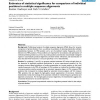52 search results - page 8 / 11 » Relating destabilizing regions to known functional sites in ... |
BMCBI
2004
13 years 7 months ago
2004
Background: In addition to known protein-coding genes, large amounts of apparently non-coding sequence are conserved between the human and mouse genomes. It seems reasonable to as...
BMCBI
2004
13 years 7 months ago
2004
Background: Profile-based analysis of multiple sequence alignments (MSA) allows for accurate comparison of protein families. Here, we address the problems of detecting statistical...
ICASSP
2007
IEEE
14 years 1 months ago
2007
IEEE
There are currently a large number of ‘‘orphan’’ G-protein-coupled receptors (GPCRs) whose endogenous ligands (peptide hormones) are unknown. Identification of these pepti...
BMCBI
2005
2005
Phylogenetic reconstruction of ancestral character states for gene expression and mRNA splicing data
13 years 7 months ago
Background: As genomes evolve after speciation, gene content, coding sequence, gene expression, and splicing all diverge with time from ancestors with close relatives. A minimum e...
BMCBI
2004
13 years 7 months ago
2004
Background: All known genomes code for a large number of transcription factors. It is important to develop methods that will reveal how these transcription factors act on a genome...


